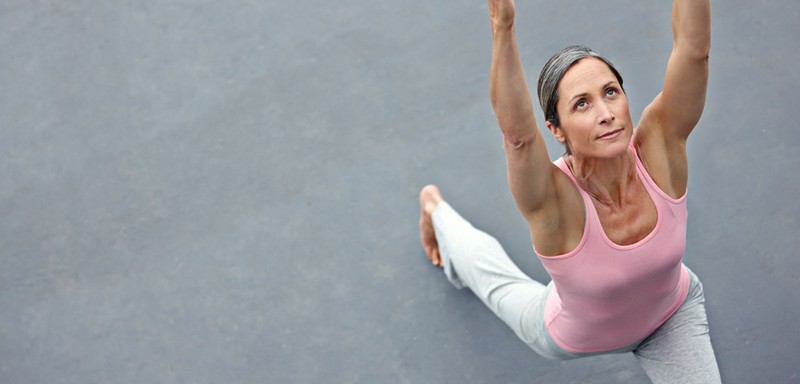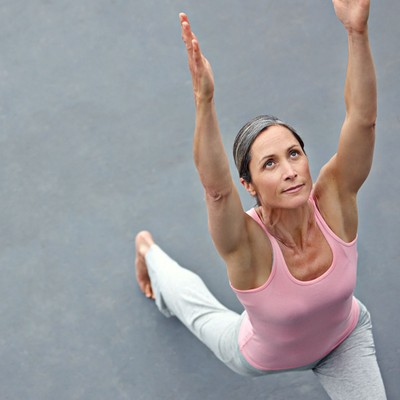

Improve Your Balance As You Age
THE PERSONAL TRAINER:
Christina Howells
Start By Taking The Balance Test
“A good test of your balance is to see how long you can stand on one leg, first with your eyes open and then with them closed. Ideally do this without shoes, with your hands on your hips. As soon as you shift your standing foot or place the opposite foot down, the test is complete. The target for a 50 to 59-year-old is 41 seconds with your eyes open and eight seconds with your eyes closed; 32 seconds eyes open and four seconds closed for 60 to 69-year-olds; and 22 seconds open and three seconds closed for a 70 to 79-year-old.”
It’s A Case Of Use It Or Lose It
“If you can’t stand on one leg for ten seconds without wobbling, then research suggests the prognosis for your health isn’t great. A risk of falls is the most obvious risk, but an inability to balance is also linked to brain health and the risk of dementia, as well as overall cognitive decline. Balance is governed largely by the cerebellum, one of the most active areas of the brain which continuously processes information from gravity to prevent us from falling over. However, if you put the effort in and commit to a regime designed to improve balance, you can challenge your brain to both regain and improve balance, thus improving your health as you age.”
Being Sedentary Doesn’t Help
“Of all the lifestyle factors that affect balance, inactivity is the most prominent. If you sit all day, you’re unlikely to be boosting the supply of blood and oxygen to the brain. Plus, if you don’t use your muscles, then muscle mass, strength and reaction times quickly decline, which has a real impact on our ability to balance and suddenly move without a risk of injury.”
Sleep Also Factors Into The Equation
“Sleep deprivation affects postural control – i.e., the task of controlling the body’s position in space to create stability and balance. Over time, a lack of sleep increases the risk of brain degeneration and the brain’s ability to recognise and organise information.”
Yoga & Tai Chi Count
“A simple way to improve balance is to make it a daily habit. Commit to balancing on one leg for as long as you can and then swap sides, perhaps whilst brushing your teeth. You can also try doing it with your eyes closed. Tai chi and yoga, meanwhile, both include a segment of standing postures. These make you focus on body awareness and reduce stress, which is also great for brain health. Stress is a definite player in poor balance as the brain becomes overloaded and struggles to process information.”
Balance Training Needn’t Be Complicated
“Train your balance three to six times a week and you’ll see improvements within a month, and significant progression within three months. This could be daily standing on one leg, advancing to doing so with your eyes closed, or it could be adding a wobble board to your routine. Also try doing a single leg stand with your opposite arm in the air, holding for ten to 30 seconds; or a single leg stand with a twist. Stand with your left knee flexed in front of the body, and then place your right hand on the left knee and twist your body to the left, maintaining an upright posture – hold for ten to 30 seconds. As a progression, try reaching the right arm towards the sky, and then repeat on the other side.”
Visit ThatGirlLondon.com
THE PHYSIOTHERAPIST:
Leanne O’Brien
It’s Important To Keep The Body Challenged
“According to the NHS, one in three adults over the age of 65 will have at least one fall each year. Balance training can drastically reduce your risk of falls, as well as ensuring you remain fit, active and mobile as you move through life. If you feel uneasy walking on rough or unstable ground, if you struggle to stand and put your socks on in the morning (without support), or if you find yourself looking for things to hold on to when taking the washing out of the machine or getting up from the floor, then you need to improve your balance.”
Reformer Pilates Works
“Reformer Pilates – more so than mat-based Pilates – is a fantastic way to improve your balance as it works on both strength and proprioceptive control. The reformer creates resistance throughout a joint’s range of motion, challenging stability and control in a way that tradition weight training can’t. You can add instability to familiar exercises such as lunges and squats, allowing you to focus more on your postural muscles, including your core and gluteal muscles. These are key stabilisers of the body and have an essential role in balance control. Ageing doesn’t have to mean a reduction in balance – unless you let it."
Pockets Of Movement Throughout The Day Add Up
“Try standing on one leg while brushing your teeth in the morning, or standing on the train instead of sitting, and trying not to hold on too much, as well as practising targeted balance exercises whilst you wait for the kettle to boil or TV adverts to finish. These are great habits to form which, over time, can make a world of difference. Heel raises are great – stand with your feet hip width apart, raising and lowering your heels without support for 15 times. Also try deep squats – stand with your feet hip width apart or more, imagining you are sitting back on a chair. Squat down as low as you can (you can place a chair behind you if you feel imbalanced), then slowly stand up again. Move your bum as low as possible without losing your balance, repeating ten times.”
Visit Ten.co.uk
THE OSTEOPATH:
Anisha Joshi
Inactivity Will Take Its Toll
“Ageing can impact your balance on its own, but also a lack of movement can cause the muscles to reduce in strength which can mean they lack the same level of control. This is the reason why many bed-bound patients have to spend time with osteopaths or physios to learn how to walk again. Also, previous ankle or knee injuries can lead to a lack of stability within those joints and consequently cause your balance to be affected. Staying active – in any form – is crucial, although yoga and Pilates are a great way to move your body gently and help specifically with balance.”
It’s Not Always About How Strong You Are
“Balance is the coordination of multiple body systems. These include your ear (vestibular), your eyes (visual) and your feeling (somatosensory) input. If you find that you’re unable to reach for something easily and pick it up or if when you are walking you feel like you’re unsteady on your feet or feel a bit dizzy, your balance may need improving. But dizziness and vertigo can also be related to many conditions, such as an ear infection. Get your eyes checked regularly – it seems simple, but sometimes patients come to me feeling unsteady and I quickly realise they need an optician, not an osteopath.”
Antioxidants Matter
“Your diet can impact the way in which your muscles and joints work, which may help improve its strength and balance ability. Foods like oily fish and leafy greens are great, and there’s research to suggest blueberries, red berries and peanuts contain an antioxidant called resveratrol that has been shown to improve balance and co-ordination. Be sure to eat plenty of omega-3 and magnesium-rich foods, supplementing if necessary.”
Visit OsteoAnisha.com
THE PILATES INSTRUCTOR:
Hollie Grant
It’s About Functional Movement
“How many times in the last 24 hours did you rotate your spine, extend your spine or pull your head back to look at the sky? Modern day lifestyles are repetitive and involve very little variety of movement, which can increase our likelihood of balance issues. When we don’t perform these movements, we don’t activate certain muscles and they become weak. This can then lead to muscular imbalances that can alter posture. When our posture changes, our centre of gravity (and balance) can be affected – it’s a snowball effect. We need to make sure we are using our bodies in as many ways as possible.”
Visit PilatesPT.co.uk
THE NUTRITIONAL THERAPIST:
Caroline Hind
What You Eat Matters
“Diet is crucial to maintaining good balance from middle age onwards as you need a good supply of protein to maintain muscle mass and strength, as well as bone density and joint function. Muscle wastage is very common in older age as our ability to absorb protein from food decreases as the same time as our muscles are less able to make use of the protein they need. This problem is compounded if processed foods that are low in protein are a mainstay of your diet. Factors such as loss of taste sensitivity, worsening dental health, declining appetite and unreliable access to home-cooked food can all contribute to low protein intake and increasing muscle and bone loss.”
Think Meat & Two Veg
“Reverting back to this dietary pattern can help ensure a good intake of protein together with the vitamins and minerals the body needs to stay strong. Stews, fish, eggs and liver are all good sources of protein for muscles; healthy fats and vitamin B12 for nerves; and vitamins D and K for bones.”
Supplements Can Be Useful
“Vitamin D can be a useful supplement to support balance, primarily through its role in maintaining bone strength. Ideally, vitamin D levels should be tested going into winter and supplementation of vitamin D dosed accordingly. In the summer, spending time outdoors should be a priority to help the body’s natural production of vitamin D. Supplementation of vitamin D is increasingly believed to be more useful to bone and overall health if taken with a supplement of vitamin K2. At the same time, collagen – a type of protein – can help balance when taken in supplement form alongside vitamin C. Collagen is used by the body to maintain bones and joints.”
Visit Vitaminology.co
DISCLAIMER: Features published by SheerLuxe are not intended to treat, diagnose, cure or prevent any disease. Always seek the advice of your GP or another qualified healthcare provider for any questions you have regarding a medical condition, and before undertaking any diet, exercise or other health-related programme.
DISCLAIMER: We endeavour to always credit the correct original source of every image we use. If you think a credit may be incorrect, please contact us at info@sheerluxe.com.

